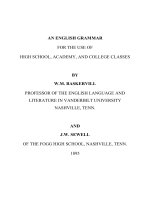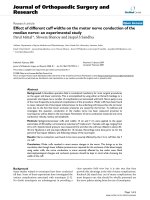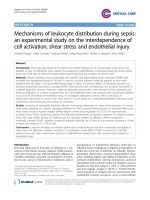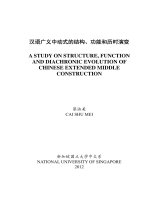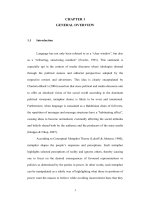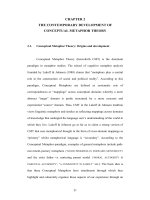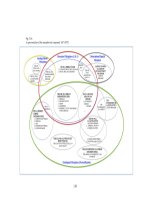An experimental study on the enhancement of mechanical properties of glass fiber reinforced polyester composite based on optimum conditions and adding multi walled carbon nanotubes
Bạn đang xem bản rút gọn của tài liệu. Xem và tải ngay bản đầy đủ của tài liệu tại đây (4.87 MB, 121 trang )
Doctor of Philosophy
An experimental study on the enhancement of mechanical
properties of glass fiber reinforced polyester composite based on
optimum conditions and adding multi-walled carbon nanotubes
The Graduate School
of the University of Ulsan
Department of Mechanical Engineering
Van-Tho Hoang
An experimental study on the enhancement of mechanical
properties of glass fiber reinforced polyester composite based on
optimum conditions and adding multi-walled carbon nanotubes
Supervisor: Professor Young-Jin Yum
A Dissertation
Submitted to
the Graduate School of the University of Ulsan
In partial Fulfillment of the Requirements
for the Degree of
Doctor of Philosophy
by
Van-Tho Hoang
Department of Mechanical Engineering
Ulsan, Korea
May, 2018
Van-Tho Hoang 의
공학박사 학위 논문을 인준함
울산대학교 대학원
기계자동차공학과
2018 년 5 월
An experimental study on the enhancement of mechanical
properties of glass fiber reinforced polyester composite based on
optimum conditions and adding multi-walled carbon nanotubes
This certifies that the dissertation
of Van-Tho Hoang is approved.
Department of Mechanical Engineering
Ulsan, Korea
May, 2018
ACKNOWLEDGEMENTS
First of all, I would like to express my deepest gratitude to my advisor Professor
Young-Jin Yum for his guidance and support throughout my Ph.D. study, especially his
kindly encouragement in not only doing research but also in my daily life. It cannot be
denied that he virtually recovers and refreshes my mind in even some tremendous
circumstances from his mild and positive thinking.
I would like to thank the Professors in the school of Mechanical Engineering at the
University of Ulsan for their great knowledge that I have learned. I would also express my
gratitude to the doctoral committee members: Prof. Seok-Jae Chu, Doctor Hee You, Prof.
Kyoung-Sick Lee, and Prof. Doo-Man Chun for their helpful feedback, suggestions and
comments to evaluate my work.
My acknowledgement is also sent to all of my friends who are always heartfelt in
their sharing, advice, and help me. They are indispensable to make me stronger and more
confident. Besides, thank you my colleagues in my own country as well as my lab mates
for their kindly helps.
The last but not least thank is for all of my family members. Words cannot express
my gratitude for everything they have done to make me into who I am. I hope I have made
them proud. I am thankful to my wife for love, care, and sharing with me every moment of
this incredible journey. I am looking forward to our better life.
Ulsan city, Republic of Korea
May, 2018
Van-Tho Hoang
v
ABSTRACT
Glass fiber reinforced polymer composites have been utilized as alternative
materials for many decades to avoid exhausting natural resources. In addition, the
applications of this material have been increasing widely. Thus, improving mechanical
properties of composite materials plays a critical role in satisfying needs in real-life
situations. Nowadays, adding multi-walled carbon nanotubes (MWCNTs) has been
showing as a high potential method due to their superlative mechanical properties.
Motivated by this tendency, the optimum conditions were found beside adding MWCNTs
to increase mechanical properties and fracture toughness of conventional composites. First
of all, the simple dispersion method was chosen to mix MWCNTs into unsaturated
polyester resin (UPR). Some optimal conditions were proposed such as mixing temperature,
initial curing temperature, hardener content, fiber changes, composite fabrication methods,
and MWCNTs content. Higher mechanical properties of separated UPR and glass fiber
reinforced UPR composites were obtained. Furthermore, some other test methods were
performed to verify the effects of optimum factors and adding MWCNTs such as
exothermic temperature measurement, thermal gravimetric analysis (TGA), density
measurement, and field emission scanning electron microscope (FE-SEM). The higher
mechanical properties and simple fabrication method can be recommended to develop
efficiently the properties of mass products.
vi
CONTENTS
ACKNOWLEDGEMENTS .................................................................................................. v
ABSTRACT ......................................................................................................................... vi
CONTENTS ........................................................................................................................ vii
LIST OF FIGURES ............................................................................................................. xii
LIST OF TABLES .............................................................................................................. xv
ABBREVIATIONS ............................................................................................................ xvi
CHAPTER 1: Introduction ................................................................................................... 1
1.1 Materials ...................................................................................................................... 5
1.1.1 Unsaturated polyester resin (UPR) ........................................................................ 5
1.1.2 Glass fibers ............................................................................................................ 8
1.1.3 Multi-walled carbon nanotubes (MWCNTs) ...................................................... 11
1.2 Application of glass fiber reinforced polymer (GFRP) ............................................. 11
1.3 Literature review ........................................................................................................ 14
1.3.1 The methods of increasing mechanical properties and fracture toughness of
GFRP composite materials. .......................................................................................... 14
1.3.2 Composite structure modification ....................................................................... 14
1.3.3 Dispersion method............................................................................................... 15
1.4 Objectives and contents of dissertation ..................................................................... 15
1.4.1 Objectives of dissertation .................................................................................... 15
1.4.2 Thesis outline ...................................................................................................... 16
CHAPTER 2: Optimization of fabrication conditions ....................................................... 17
2.1 Introduction ................................................................................................................ 18
2.2 The effect of mixing temperature .............................................................................. 19
vii
2.2.1 Materials and evaluation method ........................................................................ 19
2.2.2 Experiment .......................................................................................................... 20
2.2.3 Results and discussion......................................................................................... 21
2.2.4 Conclusions ......................................................................................................... 23
2.3 The effect of hardener ratio ....................................................................................... 23
2.3.1 Materials and evaluation methods ....................................................................... 23
2.3.2 Experiment .......................................................................................................... 23
2.3.3 Results and discussion......................................................................................... 24
2.3.3.1 Compression properties................................................................................ 24
2.3.3.2 Exothermic temperature ............................................................................... 26
2.3.4 Conclusions ......................................................................................................... 27
2.4 The effect initial curing temperature ......................................................................... 28
2.4.1 Materials and evaluation methods ....................................................................... 28
2.4.2 Experiment .......................................................................................................... 28
2.4.3 Results and discussion......................................................................................... 29
2.4.3.1 Curing behavior of UPR ............................................................................... 29
2.4.3.2 Density of UPR ............................................................................................. 31
2.4.3.3 Thermo-gravimetric analysis of UPR ........................................................... 32
2.4.3.4 Tensile properties of GFPR composites ....................................................... 32
2.4.4 Conclusions ......................................................................................................... 33
2.5 The potential of combining CSM and woven ............................................................ 34
2.5.1 Materials and evaluation methods ....................................................................... 34
2.5.2 Experiment .......................................................................................................... 34
2.5.3 Results and discussion......................................................................................... 34
viii
2.5.3.1 Thermo-gravimetric analysis of various fibers composites .......................... 34
2.5.3.2 Tensile properties of various fibers composites ........................................... 36
2.5.4 Conclusions ......................................................................................................... 37
2.6 The effect of fabrication method of GFRP composites ............................................. 37
2.6.1 Materials and evaluation methods ....................................................................... 37
2.6.2 Experiment .......................................................................................................... 38
2.6.3 Results and discussion......................................................................................... 38
2.6.3.1 Density of composite structures.................................................................... 38
2.6.3.2 Thermo-gravimetric behavior of composite structures ................................ 39
2.6.3.3 Tensile properties of composite structures ................................................... 41
2.6.4 Conclusions ......................................................................................................... 43
CHAPTER 3: Effect of multi-walled carbon nanotubes on tensile properties of
unsaturated polyester resin .................................................................................................. 43
3.1 Introduction ................................................................................................................ 44
3.2 Experiment ................................................................................................................. 45
3.2.1 Materials .............................................................................................................. 45
3.2.2 Fabrication of MWCNTs/ UPR specimens ......................................................... 45
3.2.3 Measurements...................................................................................................... 47
3.2.3.1 Tension testing .............................................................................................. 47
3.2.3.2 Observation of fracture surfaces .................................................................. 47
3.3 Results and discussion ............................................................................................... 48
3.3.1. Tensile properties of nanocomposite.................................................................. 48
3.3.2 Fracture surface observation results .................................................................... 51
3.4 Conclusions ................................................................................................................ 54
ix
CHAPTER 4: Effect of multi-walled carbon nanotubes on tensile properties of various
glass fibers/ unsaturated polyester resin composites ........................................................... 55
4.1 Introduction ................................................................................................................ 56
4.2 Experiment ................................................................................................................. 59
4.2.1 Materials .............................................................................................................. 59
4.2.2 Fabrication ........................................................................................................... 60
4.2.2.1 Matrix modification ...................................................................................... 60
4.2.2.2 Composite structure fabrication ................................................................... 60
4.2.3 Measurements...................................................................................................... 61
4.3 Results and discussion ............................................................................................... 61
4.4 Conclusions ................................................................................................................ 64
CHAPTER 5: Fracture toughness of neat UPR and various glass fibers composites ........ 65
5.1 Introduction ................................................................................................................ 66
5.2 Experiment ................................................................................................................. 68
5.2.1 Materials .............................................................................................................. 68
5.2.2 Fabrication ........................................................................................................... 68
5.2.2.1 Single-edge-notch bending (SENB) specimen for UPR ................................ 68
5.2.2.2 Double cantilever beam (DCB) and end-notched flexural (ENF) specimen
for composites ........................................................................................................... 71
5.2.3 Testing ................................................................................................................. 72
5.3 Calculations ............................................................................................................... 73
5.3.1 Plane-strain fracture toughness KIC of UPR (ASTM D5045-99) ........................ 73
5.3.2 Mode I interlaminar fracture toughness of various glass fibers reinforced UPR
composites (ASTM D5528-13) .................................................................................... 75
x
5.3.3 Mode II interlaminar fracture toughness of various glass fibers reinforced UPR
composites (ASTM D7905/D7905M-14) .................................................................... 78
5.4 Results and discussion ............................................................................................... 80
5.4.1 Effect of pre-crack method on the behavior of UPR ........................................... 80
5.4.1.1 Morphology .................................................................................................. 80
5.4.1.2 Plane-strain fracture toughness KIC and GIC of UPR .................................. 84
5.4.2 Effect of different fibers on interlaminar fracture toughness of composites....... 85
5.4.2.1 Mode I ........................................................................................................... 85
5.4.2.2 Mode II ......................................................................................................... 88
5.5 Conclusions ................................................................................................................ 89
CHAPTER 6: Conclusions and future works ..................................................................... 90
6.1 Conclusions ................................................................................................................ 91
6.2 Future works .............................................................................................................. 92
REFERENCES .................................................................................................................... 93
RESEARCH ACTIVITIES ............................................................................................... 101
xi
LIST OF FIGURES
Figure 1-1: The families of engineering materials ................................................................ 3
Figure 1-2: Strength versus density of engineering materials ............................................... 3
Figure 1-3: Evolution of engineering materials until 2020 ................................................... 4
Figure 1-4: Unsaturated polyester resin (UPR) ..................................................................... 7
Figure 1-5: Methyl ethyl ketone peroxide (MEKP) .............................................................. 7
Figure 1-6: Specific properties of metals and composites..................................................... 8
Figure 1-7: Effect of fiber volume fraction of different fibers on mechanical properties and
cost of their composites. ........................................................................................................ 9
Figure 1-8: Woven roving ................................................................................................... 10
Figure 1-9: Chopped strand mat .......................................................................................... 10
Figure 1-10: Multi-walled carbon nanotubes (CM-130) ..................................................... 11
Figure 1-11: GFRP products ............................................................................................... 13
Figure 2-1: The shape of compression specimen ................................................................ 20
Figure 2-2: Compressive stress-strain behavior of UPR at various mixing temperatures... 21
Figure 2-3: Compression specimens of UPR fabricated at different mixing temperatures . 22
Figure 2-4: Monitoring exothermic reaction ....................................................................... 24
Figure 2-5: Compression stress-strain relation of UPR with different MEKP contents. .... 25
Figure 2-6: Variation of curing temperature of UPR with different MEKP contents ......... 27
Figure 2-7: Curing behavior for different initial curing temperatures ................................ 30
Figure 2-8: Tensile properties of CSM/woven/CSM/woven for the different fabrication
temperatures......................................................................................................................... 33
Figure 2-9: Effect of fibers on the thermo-gravimetric behavior of the composites ........... 36
Figure 2-10: Tensile properties of composite structures with different of fiber components
............................................................................................................................................. 37
Figure 2-11: Effect of vacuum on the density of composite structures ............................... 39
Figure 2-12: Effect of vacuum on the thermo-gravimetric behavior of GFRP composites 41
Figure 2-13: Effect of vacuum on the tensile strength of composite structures .................. 42
xii
Figure 2-14: Effect of vacuum on the elastic modulus of composite structures ................. 43
Figure 3-1: Tensile test specimen parameters (unit: mm) ................................................... 46
Figure 3-2: Hot and stir machine ......................................................................................... 46
Figure 3-3: Aluminum casting mold ................................................................................... 47
Figure 3-4: Tensile behavior of nanocomposite with difference MWCNTs ratios ............. 50
Figure 3-5: Dispersion of MWCNTs in UPR ...................................................................... 51
Figure 3-6: Morphology of fracture surfaces ...................................................................... 53
Figure 4-1: Effects of MWCNTs on the tensile strength of various fibers composite ........ 63
Figure 4-2: Effects of MWCNTs on the elastic modulus of various fibers composite ....... 63
Figure 5-1: Aluminum mold for casting UPR ..................................................................... 69
Figure 5-2: The shape and parameter of SENB specimen................................................... 69
Figure 5-3: UPR after casting in aluminum mold ............................................................... 70
Figure 5-4: Configuration of mode I and mode II specimens ............................................. 71
Figure 5- 5: Configuration of mode I and mode II specimens ............................................ 73
Figure 5-6: Load-displacement curve of UPR ..................................................................... 74
Figure 5-7: Determination of correcting delamination length (Figure 4, Ref. 103) ............ 76
Figure 5-8: Linear regression function of cube root of compliance and delamination length
............................................................................................................................................. 77
Figure 5-9: Load, displacement, and delamination length of mode I test ........................... 77
Figure 5-10: Load - displacement curve of different crack length in fracture test .............. 79
Figure 5-11: Linear regression function of compliance and delamination length cubed .... 79
Figure 5-12: The notch of SENB specimen after curing ..................................................... 80
Figure 5-13: The configuration and surfaces of specimen after fracture test ...................... 83
Figure 5-14: Fracture surface of UPR after fracture test: (a) 2D model and (b) 3D model 83
Figure 5-15: Critical stress intensity factor of different pre-crack methods........................ 84
Figure 5-16: Delamination resistance curves with different fibers composites .................. 86
xiii
Figure 5-17: Mode I interlaminar fracture toughness of various glass fibers composite .... 87
Figure 5-18: Fiber bridging of different glass fibers composite .......................................... 87
Figure 5-19: Mode II fracture toughness of different glass fibers composite ..................... 88
Figure 5-20: The specimens after mode II fracture test....................................................... 89
xiv
LIST OF TABLES
Table 2-1: Compression properties of UPR at various mixing temperatures. ..................... 22
Table 2-2: Compression properties of UPR based on the difference of hardener ratios ..... 26
Table 2-3: Density of the materials. .................................................................................... 31
Table 2-4: Density of UPR for the different initial curing temperatures............................. 31
Table 2-5: Thermal behavior of UPR for the different initial curing temperatures. ........... 32
Table 4-1: Fiber weight fraction in different cases.............................................................. 61
Table 5-1: The shape of pre-crack with different methods. ................................................ 81
Table 5-2: The surface of pre-crack after fracture test. ....................................................... 81
Table 5-3: The difference in pre-crack method. .................................................................. 85
Table 5-4: GIC of the different pre-crack methods. ............................................................. 85
xv
ABBREVIATIONS
PMCs : Polymer matrix composites
FRP
: Fiber reinforced plastic
GFRP : Glass fiber reinforced plastics
UPR
: Unsaturated polyester resin
MEKP : Methyl ethyl ketone peroxide
CSM (M): Chopped strand mat (Mat)
W
: Woven (Roving)
CNTs : Carbon nanotubes
SWCNTs: Single-walled carbon nanotubes
DWCNTs: Double-walled carbon nanotubes
MWCNTs: Multi-walled carbon nanotubes
FE-SEM: Field emission scanning electron microscopy
ASTM : American Society for Testing and Materials
SENB : Single-edge-notch bending
CT
: Compact tension
DCB : Double cantilever beam
ENF
: End-notched flexural
LEFM : Linear elastic fracture mechanics
xvi
CHAPTER 1:
Introduction
1
The first composite materials were used at around the 1,500 B.C. by mixing mud
and straw to create strong and durable buildings. The definition of composite materials has
been likely started from that time and has not changed until now [1]. The objectives of
composite materials are almost conserved historically in order to obtain the better
mechanical and physical properties, light weight etc. The improvement can be obtained
from each component or all of them as long as improved reinforcement and/or improved
matrix combined.
The time has been going with so many events in all over the world such as World
War 1, 2. The composite materials have been also improving to adapt the specific purposes.
In the early 1,900s, some plastics were found as vinyl, polystyrene, phenolic, and polyester
[2]. In 1935, the first glass fiber were known when it was combined with a plastic polymer
by Owen Corning [2]. From that time fiber reinforced polymers (FRP) became well-known
in industry as well as in military aircraft due to the lightweight and strong alternative
materials [2]. In 1946, FPR was used in boat hull commercially after lower demand from
military products [2]. And, nowadays, it is a common materials with other wider
applications such as electronics, home and furniture, medical, automobile etc. [3, 4].
Indeed, FRP has been used as alternative materials to avoid exhausting natural resources
and it also exhibits the desirable characteristics including low density, high specific
strength, high specific modulus, high corrosion resistance, and low cost [1]. Additionally,
Michael F. Ashby [5] has listed the families of engineering material (Figure 1-1), their
mechanical strength (Figure 1-2), and the evolution until 2020 (Figure 1-3) for the
selection in mechanical design. It is not only convenient for design procedure but also
helpful to understand easily the role of composite materials in the material world.
2
Figure 1-1: The families of engineering materials [Figure 3.1, Ref. 5]
Figure 1-2: Strength versus density of engineering materials [Figure 4.4, Ref. 5]
3
Figure 1-3: Evolution of engineering materials until 2020 [Figure 1.1, Ref. 5]
There are totally four classes of matrix materials, they are polymers, metals,
ceramics, and carbon while polymer matrix composites (PMCs) are by far the most widely
used types [6]. Thermosets and thermoplastic are two major classes of polymers. And
thermosetting polymers are by far the most widely used matrix resins for structural
applications due to its advantages. The main characteristic of thermosetting polymers is to
undergo a curing process, after that they are rigid and cannot be reformed. On the other
hand, thermoplastics can be reused by application of heat [6]. FRP has been known well as
fibers reinforced thermosetting resin composites. Many manufacturing methods were born
not only to adapt the vital applications and their scale in industry but also to improve the
properties and quality of composites [3, 7]. For the open mold process, hand lay-up and
spray up methods are commonly used to fabricate FRP [7]. The quality of "second surface"
of products can be provided better by closed mold process including matched-die, resin
4
injection molding, compression molding, transfer molding (vacuum bag molding/ resin
transfer molding/ vacuum infusion), press molding, autoclave molding methods [7].
Vacuum assisted hand lay-up method is combined manual stacking method and vacuum,
that is not a current method but it can produce a appropriate quality and mechanical
properties of composites.
The demand of increasing mechanical and physical properties of composite
materials is unstoppable. The complicated working environment of various applications
has been motivated to find better products. Nowadays, fabrication technology is strongly
developing that can promote to create better composite material generations. Especially,
the appearance of graphene and carbon nanotubes (CNTs) that have been expressed the
superlative properties in mechanical, electrical, and chemical prospects. There are many
related researches that have been utilizing these subjects to build nano-composite materials.
In this dissertation, tensile properties of thermosetting resin (unsaturated polyester
resin) and various glass fiber/ unsaturated polyester resin are focused. To understand fully
mechanical behavior and fracture toughness of FRP composites, multi-walled carbon
nanotubes were also used based on some optimum fabrication conditions without any
chemical treatment.
1.1 Materials
1.1.1 Unsaturated polyester resin (UPR)
Unsaturated polyester resin is the solutions of unsaturated polyester and vinyl
monomers (reactive diluents) in form of three dimensional network backbone [8]. The
viscosity of UPR is reduced from the high range 103 - 105 (mPa.s or cps) of unsaturated
5
polyester to much lower range of 100 - 500 cps due to the reactive diluents. Compared to
the Newtonian fluid (water) with 1 cps, we can see UPR has so high viscosity.
The curing behavior is the specific characteristic of UPR, that was presented deeply
in the reference [8] as follows: The curing reaction of UPR is a free radical chain growth
cross-linking polymerization between the reactive diluents (styrene monomers) and
unsaturated resin. While, polyester molecules are the cross-linkers and reactive diluents
work as agent to link the adjacent polyester molecules. At the room temperature, methyl
ethyl ketone peroxide (MEKP) is used as initiator for large hand lay-up structures. The
curing of UPR leads to volume shrinkage. When the reaction starts, the initiator
decomposes to form free radicals initiating polymerization which link adjacent unsaturated
resin chains through connecting styrene monomers by both inter- and intra-molecular
reactions (three dimensional network). As the polymerization continues, the temperature
and degree of polymerization increases causes shrinkage. The polymerization shrinkage of
UPR phase causes a large stress in monomer phase leading to formation of micro-voids.
The polymer coils get tightened up to form the so-called "micro-gel" structure. The
concentration of the micro-gel increase continuously leading to macro-gelation. The curing
process of UPR can be divided into four stages: induction, micro-gel formation, transition,
and macro-gelation. In the induction period, the free radicals are consumed by the initiator
and very little polymerization takes place. In the second stage, spherical structures (microgel particles) with high cross-link density are formed. In transition stage the (C=C) double
bonds buried inside the micro-gel undergo intra-molecular cross-linking while those on
surface react with micro-gels. This results in growth of micro-gel. Finally macro-gelation
takes place by inter-molecular micro-gels and micro-gel clusters including a sharp increase
in viscosity of UPR.
6
The commercial UPR and MEKP are shown in figure 1-4 and 1-5, respectively that
were made by Aekyung chemical company in South Korea.
Figure 1-4: Unsaturated polyester resin (UPR)
Figure 1-5: Methyl ethyl ketone peroxide (MEKP)
7
1.1.2 Glass fibers
From reference [8], there are many type of artificial synthesis fibers in the world of
fiber reinforcement composites such as glass fibers, carbon (graphite) fibers, kevlar
(aramid) fibers, boron fibers, etc. They have been showing the better candidate in
comparison with metal because of their high specific strength, high specific modulus, high
corrosion resistance, low cost, low density etc. Among them, glass fibers are responsible
for majority of FRP composites because an acceptable manufactured cost although they
have lower specific properties. The adequate mechanical properties, suitable cost, good
specific electrical insulation purpose can be applied by glass fiber reinforced polymer
(GFRP) composites. The comparison in specific strength and modulus of some fibers in
their composites can be seen at Figure 1-6.
Figure 1-6: Specific properties of metals and composites [Figure 1, part 2.05, Ref. 8]
8
In the group of GFRP, there are many classes such as E glass, S glass, S-2 glass, C
glass, D glass, A glass, prepreg, chopped strand mat (CSM), woven roving etc. They were
synthesized for specific purpose with the different mechanical and physical behaviors. As
other fiber composites, GFRP also can be aligned to reinforce in specific direction to
improve local strength of structures. In composite structures, fibers contribute as
reinforcement component while polymers play as matrix binder role. Consequently, for
GFRP, to obtain the desirable mechanical properties, the fiber orientation and the fiber
volume fraction can be changed. The fiber volume fraction could be chosen in range of 6070% in fabrication as long as composite structures can be formed. The difference fiber
types and fiber volume fractions represent difference properties and prices as Figure 1-7.
Figure 1-7: Influence of reinforcement type and quantity on composite performance
[Figure 1.2, Ref. 9].
9

